EX-99.2
Published on November 10, 2010
Exhibit 99.2
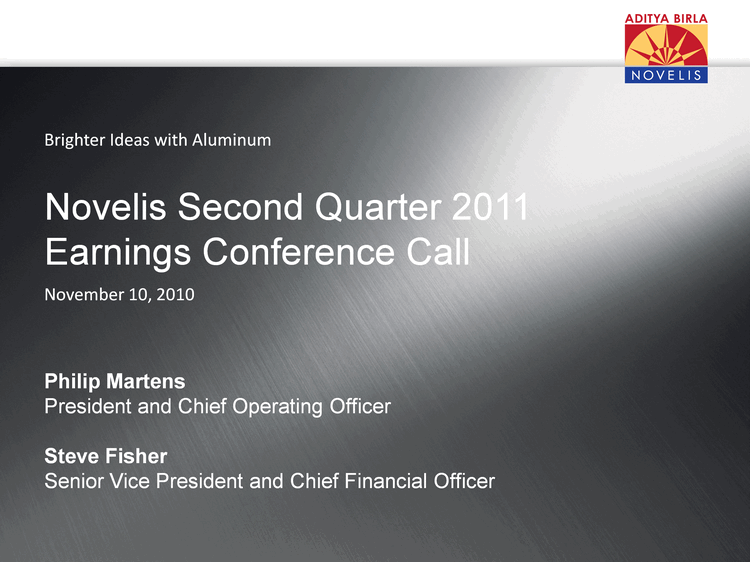
| Novelis Second Quarter 2011 Earnings Conference Call Philip Martens President and Chief Operating Officer Steve Fisher Senior Vice President and Chief Financial Officer Brighter Ideas with Aluminum November 10, 2010 |
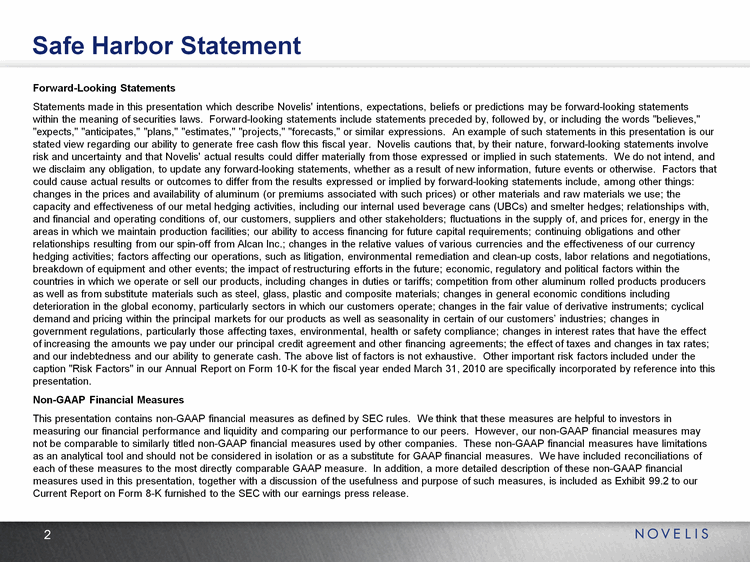
| Forward-Looking Statements Statements made in this presentation which describe Novelis' intentions, expectations, beliefs or predictions may be forward-looking statements within the meaning of securities laws. Forward-looking statements include statements preceded by, followed by, or including the words "believes," "expects," "anticipates," "plans," "estimates," "projects," "forecasts," or similar expressions. An example of such statements in this presentation is our stated view regarding our ability to generate free cash flow this fiscal year. Novelis cautions that, by their nature, forward-looking statements involve risk and uncertainty and that Novelis' actual results could differ materially from those expressed or implied in such statements. We do not intend, and we disclaim any obligation, to update any forward-looking statements, whether as a result of new information, future events or otherwise. Factors that could cause actual results or outcomes to differ from the results expressed or implied by forward-looking statements include, among other things: changes in the prices and availability of aluminum (or premiums associated with such prices) or other materials and raw materials we use; the capacity and effectiveness of our metal hedging activities, including our internal used beverage cans (UBCs) and smelter hedges; relationships with, and financial and operating conditions of, our customers, suppliers and other stakeholders; fluctuations in the supply of, and prices for, energy in the areas in which we maintain production facilities; our ability to access financing for future capital requirements; continuing obligations and other relationships resulting from our spin-off from Alcan Inc.; changes in the relative values of various currencies and the effectiveness of our currency hedging activities; factors affecting our operations, such as litigation, environmental remediation and clean-up costs, labor relations and negotiations, breakdown of equipment and other events; the impact of restructuring efforts in the future; economic, regulatory and political factors within the countries in which we operate or sell our products, including changes in duties or tariffs; competition from other aluminum rolled products producers as well as from substitute materials such as steel, glass, plastic and composite materials; changes in general economic conditions including deterioration in the global economy, particularly sectors in which our customers operate; changes in the fair value of derivative instruments; cyclical demand and pricing within the principal markets for our products as well as seasonality in certain of our customers' industries; changes in government regulations, particularly those affecting taxes, environmental, health or safety compliance; changes in interest rates that have the effect of increasing the amounts we pay under our principal credit agreement and other financing agreements; the effect of taxes and changes in tax rates; and our indebtedness and our ability to generate cash. The above list of factors is not exhaustive. Other important risk factors included under the caption "Risk Factors" in our Annual Report on Form 10-K for the fiscal year ended March 31, 2010 are specifically incorporated by reference into this presentation. Non-GAAP Financial Measures This presentation contains non-GAAP financial measures as defined by SEC rules. We think that these measures are helpful to investors in measuring our financial performance and liquidity and comparing our performance to our peers. However, our non-GAAP financial measures may not be comparable to similarly titled non-GAAP financial measures used by other companies. These non-GAAP financial measures have limitations as an analytical tool and should not be considered in isolation or as a substitute for GAAP financial measures. We have included reconciliations of each of these measures to the most directly comparable GAAP measure. In addition, a more detailed description of these non-GAAP financial measures used in this presentation, together with a discussion of the usefulness and purpose of such measures, is included as Exhibit 99.2 to our Current Report on Form 8-K furnished to the SEC with our earnings press release. Safe Harbor Statement |
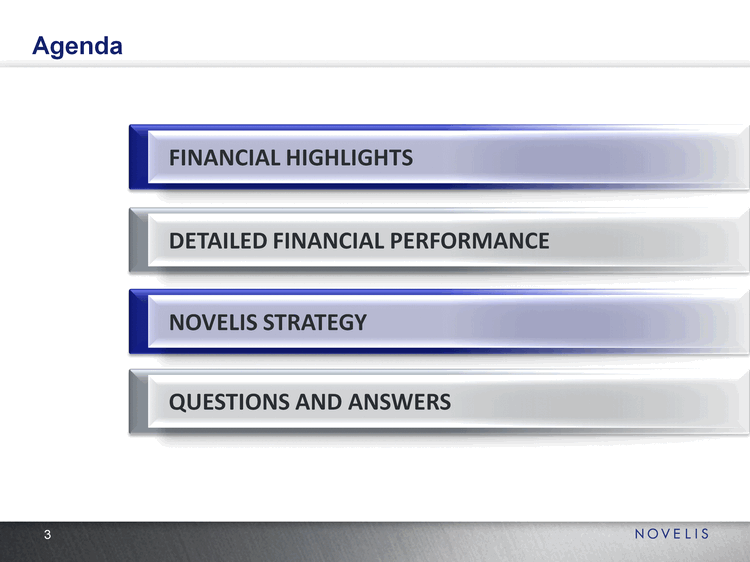
| DETAILED FINANCIAL PERFORMANCE NOVELIS STRATEGY QUESTIONS AND ANSWERS FINANCIAL HIGHLIGHTS Agenda |
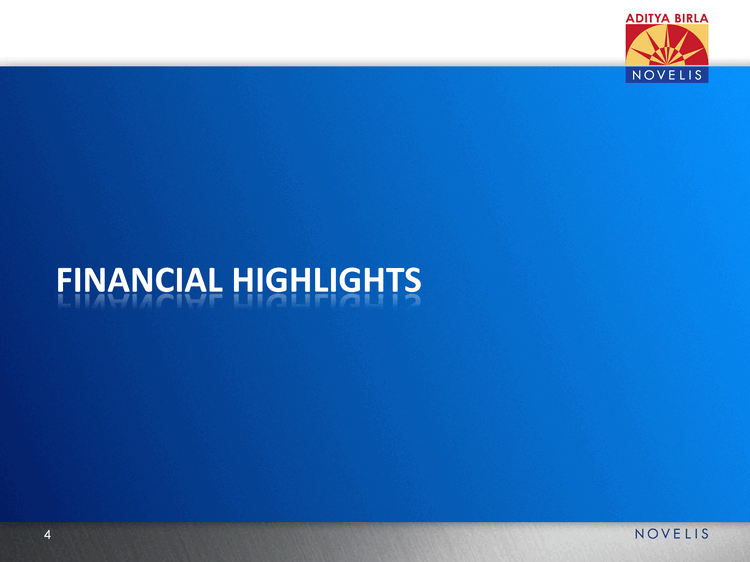
| FINANCIAL HIGHLIGHTS |
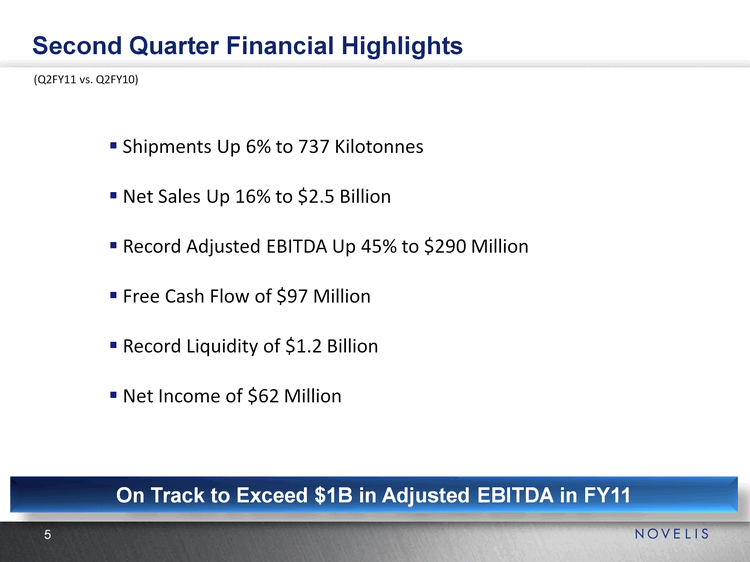
| Second Quarter Financial Highlights (Q2FY11 vs. Q2FY10) On Track to Exceed $1B in Adjusted EBITDA in FY11 Shipments Up 6% to 737 Kilotonnes Net Sales Up 16% to $2.5 Billion Record Adjusted EBITDA Up 45% to $290 Million Free Cash Flow of $97 Million Record Liquidity of $1.2 Billion Net Income of $62 Million |
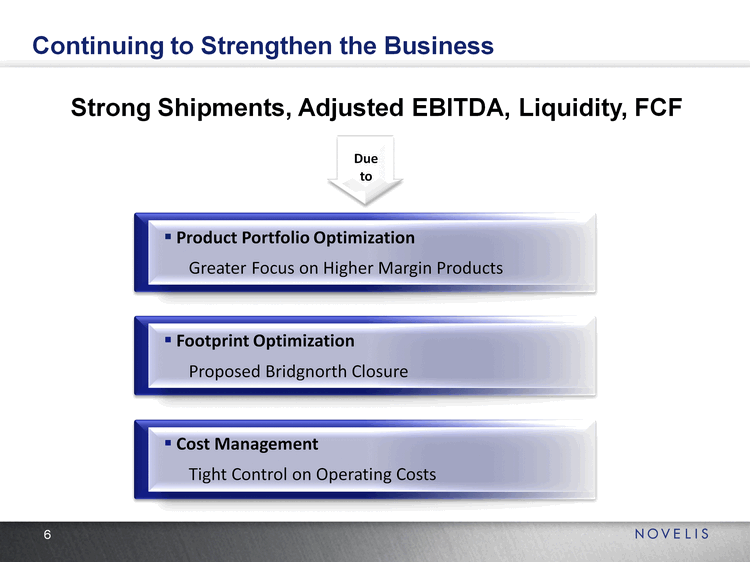
| Strong Shipments, Adjusted EBITDA, Liquidity, FCF Due to Product Portfolio Optimization Greater Focus on Higher Margin Products Footprint Optimization Proposed Bridgnorth Closure Cost Management Tight Control on Operating Costs Continuing to Strengthen the Business |
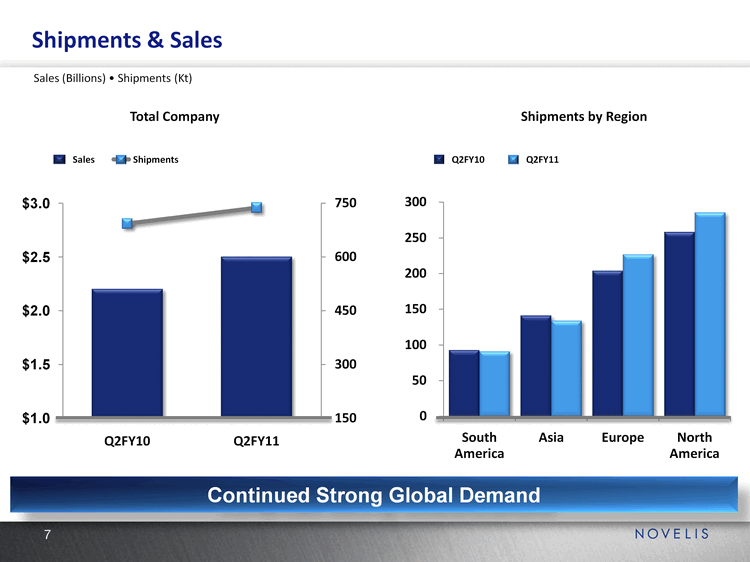
| (CHART) Shipments & Sales (CHART) Shipments by Region Total Company Sales (Billions) Shipments (Kt) Continued Strong Global Demand Sales Q2FY10 |
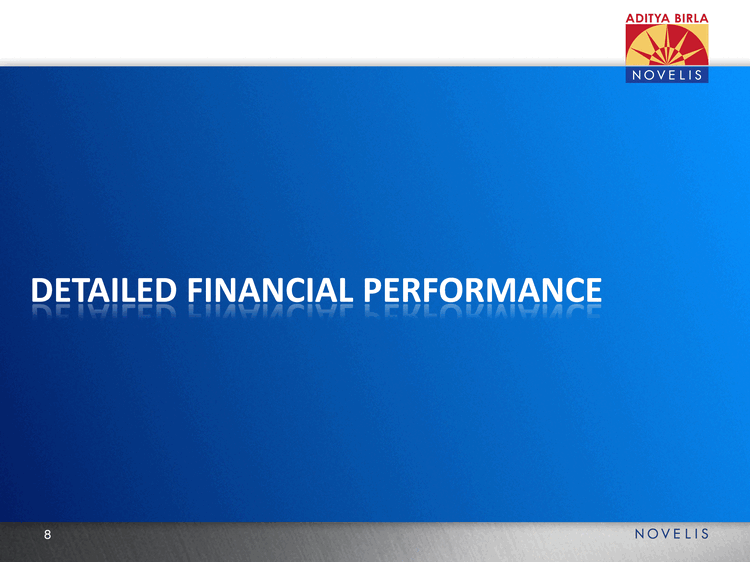
| DETAILED FINANCIAL PERFORMANCE |
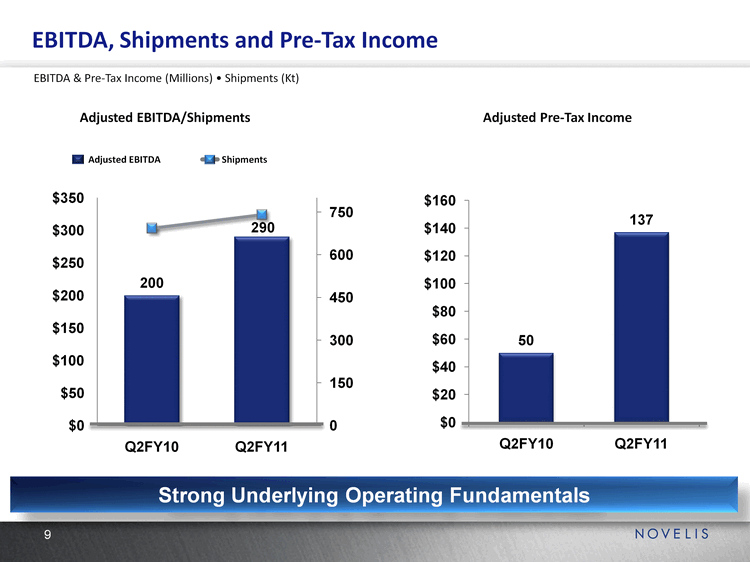
| (CHART) (CHART) Adjusted EBITDA/Shipments Adjusted Pre-Tax Income EBITDA, Shipments and Pre-Tax Income Strong Underlying Operating Fundamentals EBITDA & Pre-Tax Income (Millions) Shipments (Kt) Shipments Adjusted EBITDA |
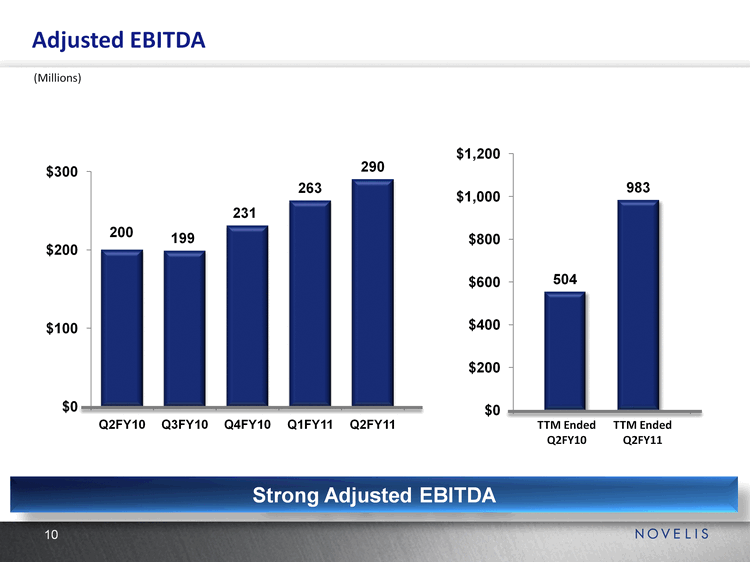
| (Millions) (CHART) Adjusted EBITDA Strong Adjusted EBITDA (CHART) TTM Ended Q2FY10 TTM Ended Q2FY11 |
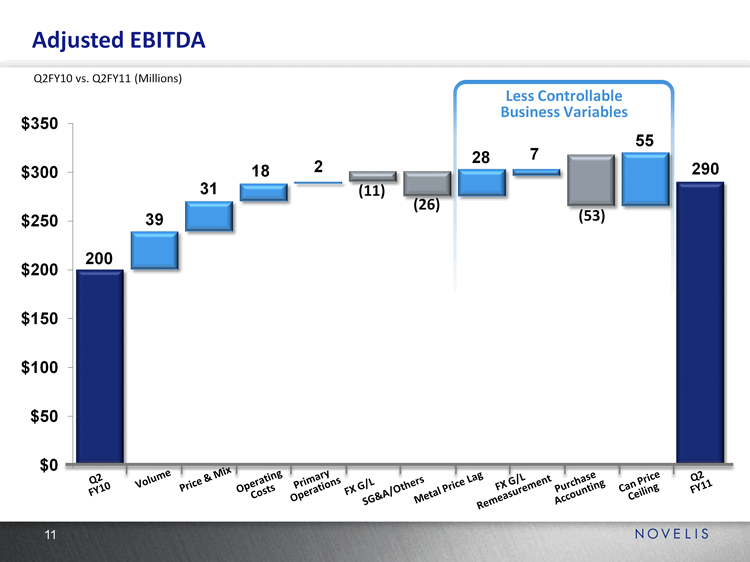
| Less Controllable Business Variables Business Variables Business Variables Q2 FY10 Volume Price & Mix Operating Costs Primary Operations SG&A/Others FX G/L Metal Price Lag FX G/L Remeasurement Purchase Accounting Can Price Ceiling Q2 FY11 Adjusted EBITDA Q2FY10 vs. Q2FY11 (Millions) (26) (11) (53) |
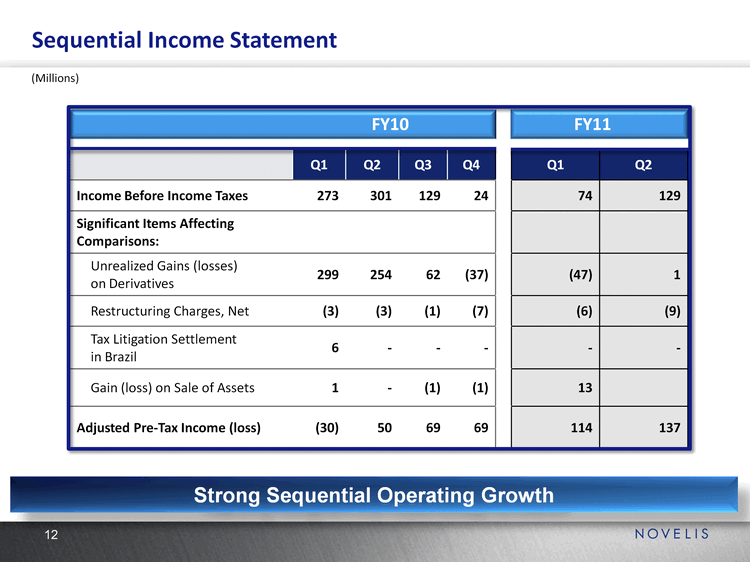
| Q1 Q2 Q3 Q4 Q1 Q2 Income Before Income Taxes 273 301 129 24 74 129 Significant Items Affecting Comparisons: Significant Items Affecting Comparisons: Significant Items Affecting Comparisons: Significant Items Affecting Comparisons: Significant Items Affecting Comparisons: Unrealized Gains (losses) on Derivatives 299 254 62 (37) (47) 1 Restructuring Charges, Net (3) (3) (1) (7) (6) (9) Tax Litigation Settlement in Brazil 6 - - - - - Gain (loss) on Sale of Assets 1 - (1) (1) 13 Adjusted Pre-Tax Income (loss) (30) 50 69 69 114 137 (Millions) FY10 FY11 Sequential Income Statement Strong Sequential Operating Growth |

| (CHART) (Millions) Now Focused on Strategic Capital Allocation Decisions Strong Liquidity Availability Under the ABL Facility |
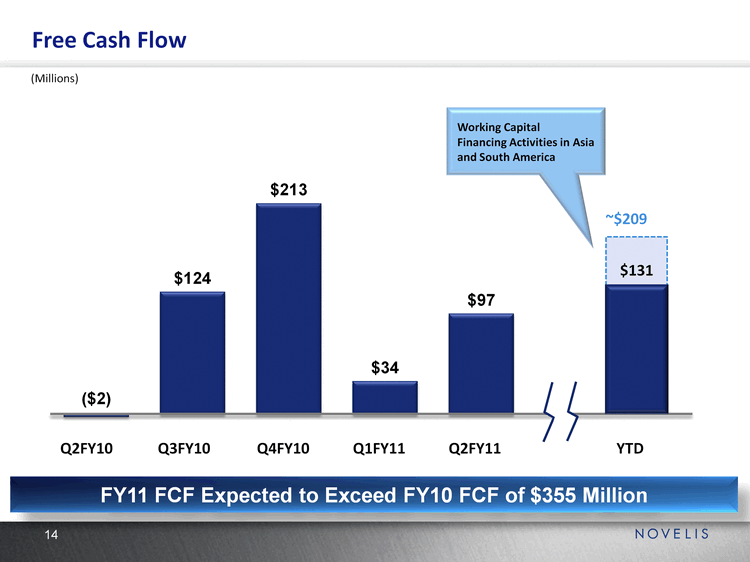
| (Millions) Working Capital Financing Activities in Asia and South America Free Cash Flow FY11 FCF Expected to Exceed FY10 FCF of $355 Million (CHART) ~$209 YTD Q2FY11 Q1FY11 Q4FY10 Q3FY10 Q2FY10 (CHART) |
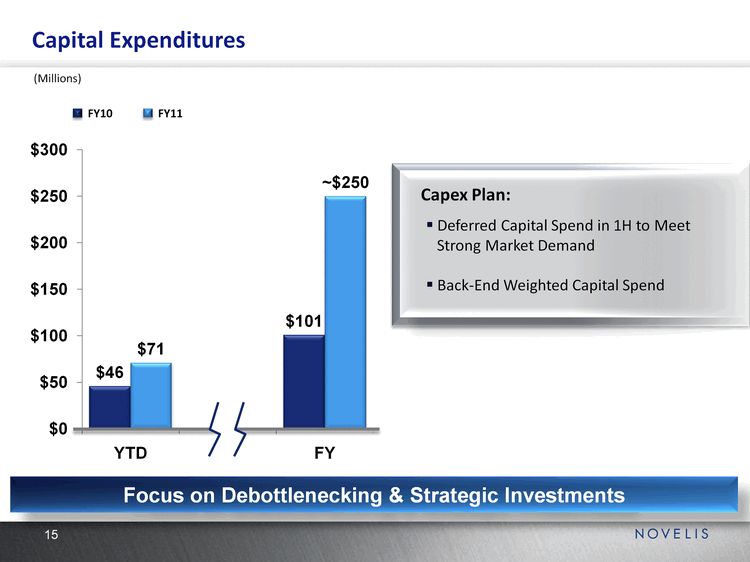
| (CHART) (Millions) Capital Expenditures Focus on Debottlenecking & Strategic Investments Capex Plan: Deferred Capital Spend in 1H to Meet Strong Market Demand Back-End Weighted Capital Spend FY11 |

| NOVELIS STRATEGY |
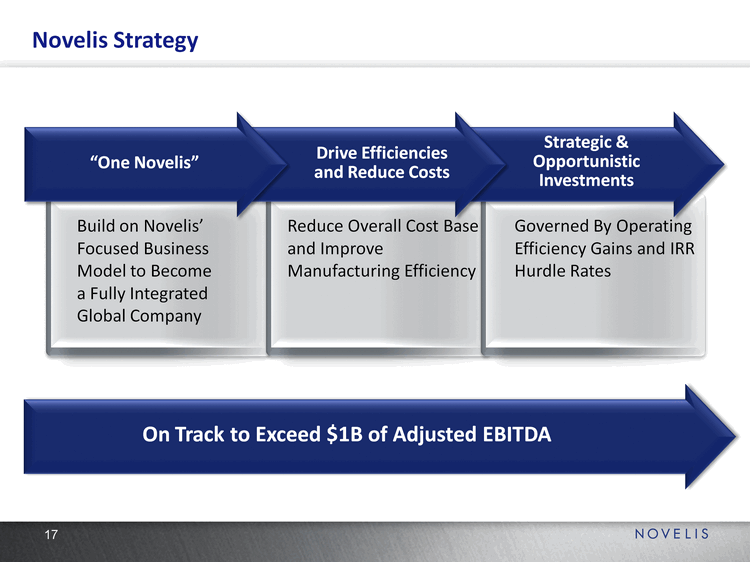
| Reduce Overall Cost Base and Improve Manufacturing Efficiency Governed By Operating Efficiency Gains and IRR Hurdle Rates Drive Efficiencies and Reduce Costs On Track to Exceed $1B of Adjusted EBITDA Strategic & Opportunistic Investments Novelis Strategy Build on Novelis' Focused Business Model to Become a Fully Integrated Global Company "One Novelis" |
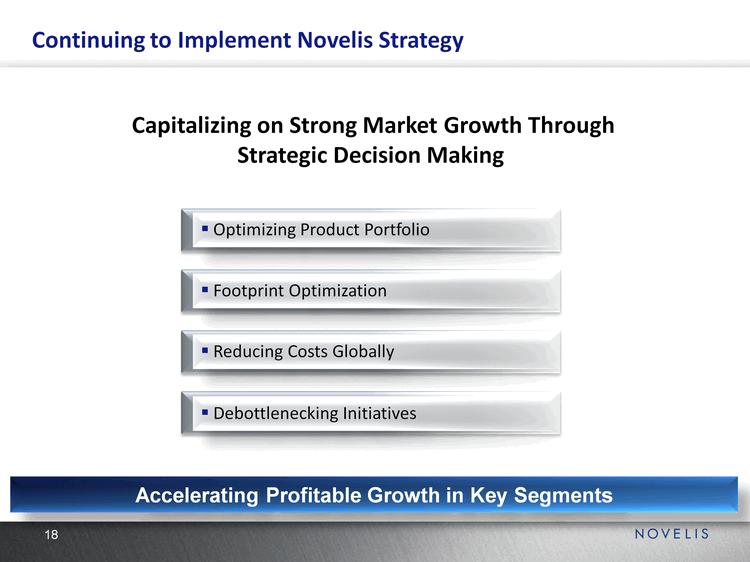
| Capitalizing on Strong Market Growth Through Strategic Decision Making Continuing to Implement Novelis Strategy Accelerating Profitable Growth in Key Segments Optimizing Product Portfolio Footprint Optimization Debottlenecking Initiatives Reducing Costs Globally |
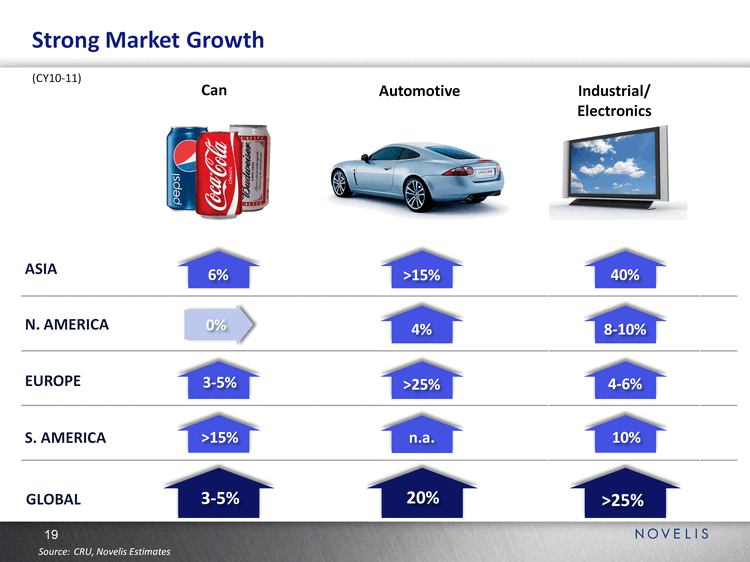
| Source: CRU, Novelis Estimates Strong Market Growth N. AMERICA EUROPE S. AMERICA ASIA GLOBAL Automotive >15% 4% >25% n.a. 20% Can 6% 0% >15% 3-5% 3-5% Industrial/ Electronics 40% 10% >25% 8-10% 4-6% (CY10-11) |

| (CHART) (CHART) Current State (FY10) Future State 63% Premium Products 37% Other Other Premium Products Optimizing Product Portfolio Accelerating Profitable Growth in Key Segments |
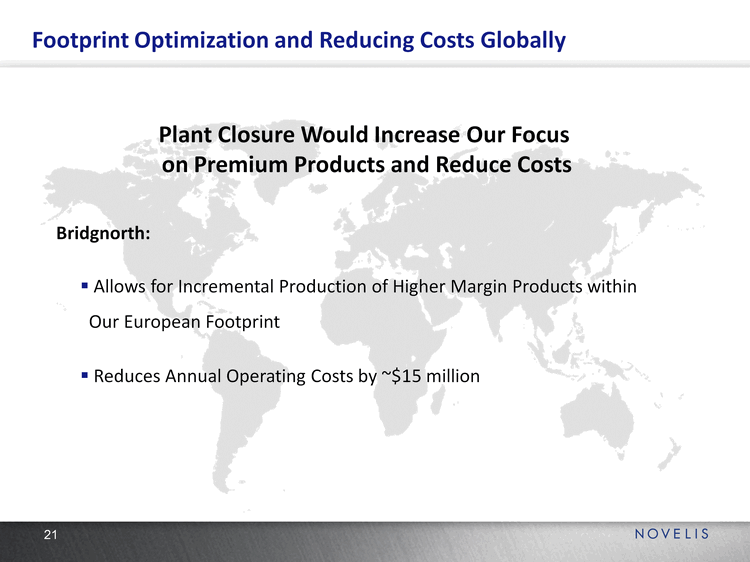
| Bridgnorth: Footprint Optimization and Reducing Costs Globally Allows for Incremental Production of Higher Margin Products within Our European Footprint Reduces Annual Operating Costs by ~$15 million Plant Closure Would Increase Our Focus on Premium Products and Reduce Costs |
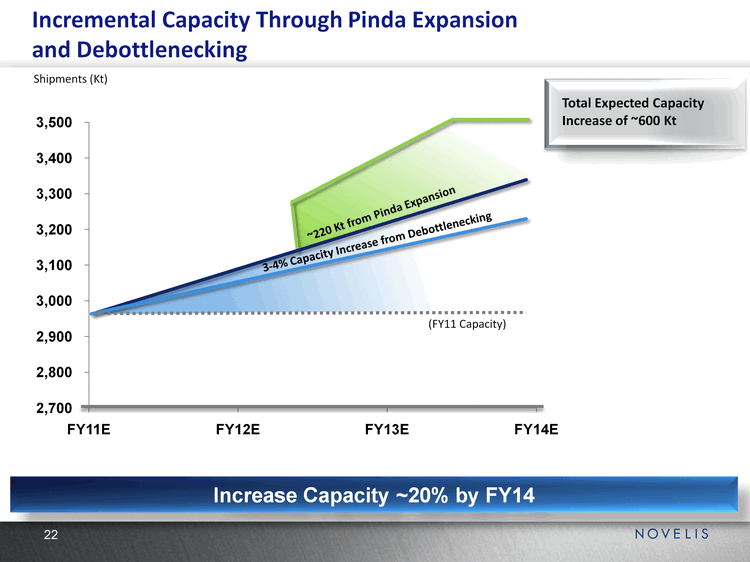
| (CHART) Shipments (Kt) (FY11 Capacity) Total Expected Capacity Increase of ~600 Kt ~220 Kt from Pinda Expansion 3-4% Capacity Increase from Debottlenecking Incremental Capacity Through Pinda Expansion and Debottlenecking Increase Capacity ~20% by FY14 |
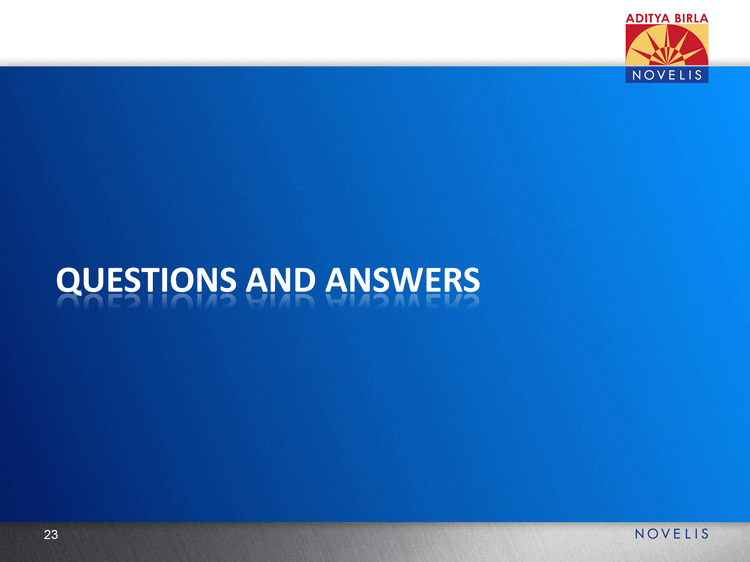
| QUESTIONS AND ANSWERS |
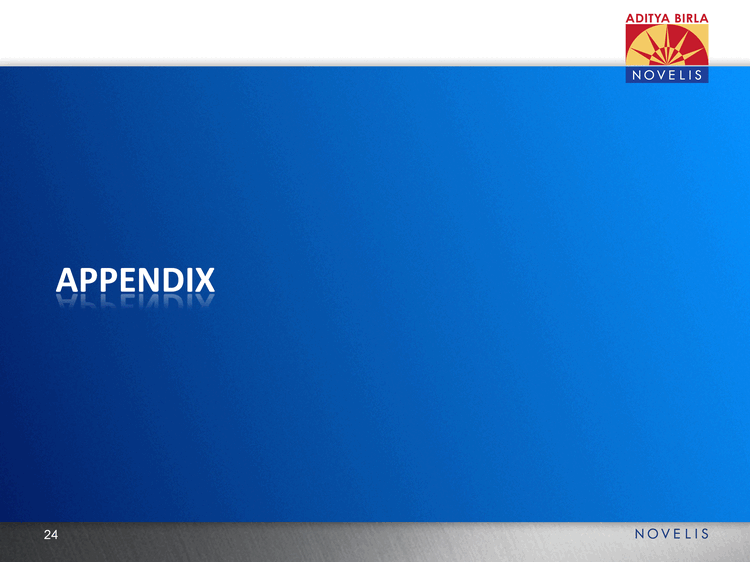
| APPENDIX |

| (in $ m) Q1 FY09 Q2 FY09 Q3 FY09 Q4 FY09 FY 09 Q1 FY10 Q2 FY10 Q3 FY10 Q4 FY10 FY 10 Q1 FY11 Q2FY11 Net Income (loss) Attributable to Our Common Shareholder 24 (104) (1,814) (16) (1,910) 143 195 68 (1) 405 50 62 - Interest, net (40) (41) (44) (43) (168) (40) (41) (42) (41) (164) (36) (37) - Income tax (provision) benefit (35) 168 196 (83) 246 (112) (87) (48) (15) (262) (15) (56) - Depreciation and amortization (116) (107) (107) (109) (439) (100) (92) (93) (99) (384) (103) (104) - Noncontrolling interests (2) - 9 5 12 (18) (19) (13) (10) (60) (9) (11) EBITDA 217 (124) (1,868) 214 (1,561) 413 434 264 164 1,275 213 270 - Unrealized gain (loss) on derivatives 20 (221) (463) 145 (519) 299 254 62 (37) 578 (47) 1 - Impairment charges - - (1,500) - (1,500) - - - - - - - - Gain on debt exchange - - - 122 122 - - - - - - - - Proportional consolidation (18) (18) (14) (16) (66) (16) (17) 2 (20) (51) (10) (11) - Restructuring charges, net 1 - (15) (81) (95) (3) (3) (1) (7) (14) (6) (9) - Others costs, net (4) 27 (3) (9) 11 9 - 2 (3) 8 13 (1) Adjusted EBITDA 218 88 127 53 486 124 200 199 231 754 263 290 Other Income (expense) Included in Adjusted EBITDA - Metal price lag 38 (11) (2) (5) 20 (30) (10) 3 2 (35) 9 19 - Foreign currency remeasurement (24) (53) 29 (18) (66) 5 13 (6) 4 16 (22) 20 - Purchase accounting 62 58 50 53 223 52 49 42 (2) 141 - (4) - Can price ceiling, net (74) (72) (40) (40) (226) (54) (54) (20) - (128) - - Income Statement Reconciliation to Adjusted EBITDA |
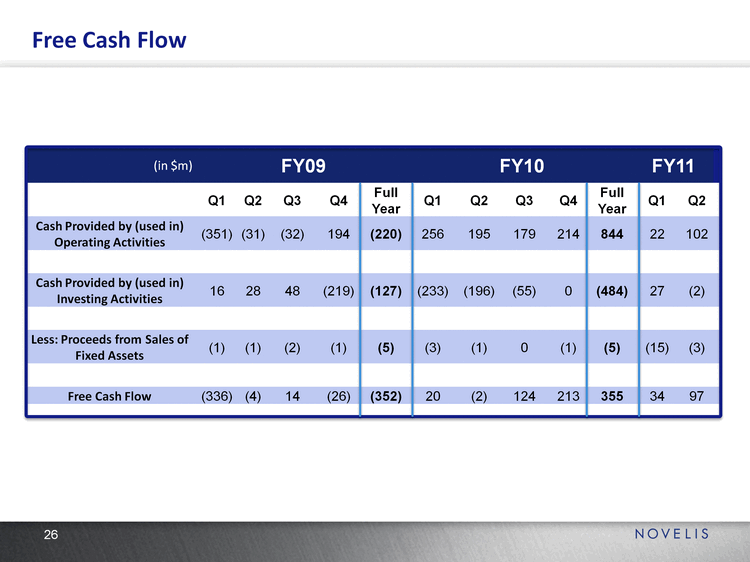
| (in $m) FY09 FY09 FY09 FY09 FY09 FY10 FY10 FY10 FY10 FY10 FY11 FY11 Q1 Q2 Q3 Q4 Full Year Q1 Q2 Q3 Q4 Full Year Q1 Q2 Cash Provided by (used in) Operating Activities (351) (31) (32) 194 (220) 256 195 179 214 844 22 102 Cash Provided by (used in) Investing Activities 16 28 48 (219) (127) (233) (196) (55) 0 (484) 27 (2) Less: Proceeds from Sales of Fixed Assets (1) (1) (2) (1) (5) (3) (1) 0 (1) (5) (15) (3) Free Cash Flow (336) (4) 14 (26) (352) 20 (2) 124 213 355 34 97 Free Cash Flow |
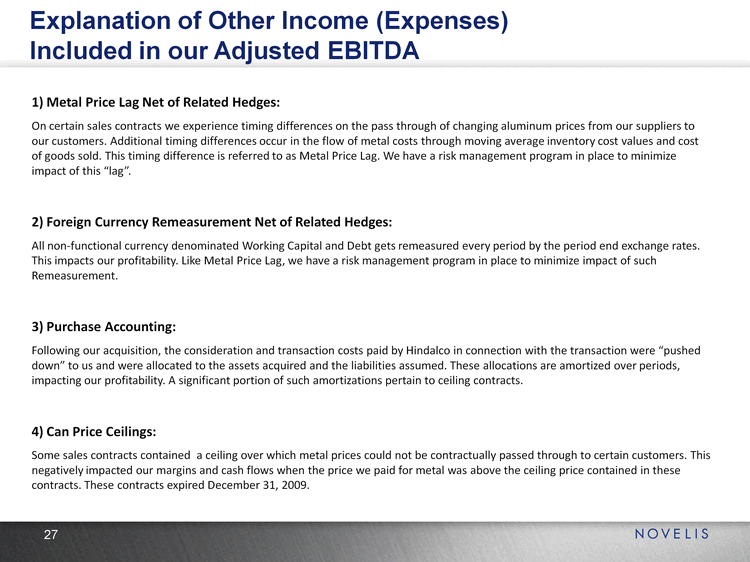
| Explanation of Other Income (Expenses) Included in our Adjusted EBITDA 1) Metal Price Lag Net of Related Hedges: On certain sales contracts we experience timing differences on the pass through of changing aluminum prices from our suppliers to our customers. Additional timing differences occur in the flow of metal costs through moving average inventory cost values and cost of goods sold. This timing difference is referred to as Metal Price Lag. We have a risk management program in place to minimize impact of this "lag". 2) Foreign Currency Remeasurement Net of Related Hedges: All non-functional currency denominated Working Capital and Debt gets remeasured every period by the period end exchange rates. This impacts our profitability. Like Metal Price Lag, we have a risk management program in place to minimize impact of such Remeasurement. 3) Purchase Accounting: Following our acquisition, the consideration and transaction costs paid by Hindalco in connection with the transaction were "pushed down" to us and were allocated to the assets acquired and the liabilities assumed. These allocations are amortized over periods, impacting our profitability. A significant portion of such amortizations pertain to ceiling contracts. 4) Can Price Ceilings: Some sales contracts contained a ceiling over which metal prices could not be contractually passed through to certain customers. This negatively impacted our margins and cash flows when the price we paid for metal was above the ceiling price contained in these contracts. These contracts expired December 31, 2009. |